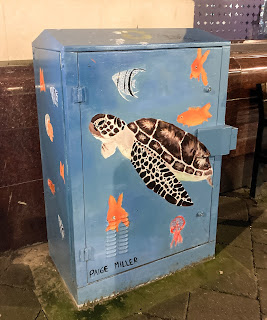Over the weekend of 1 - 2 Mar, I was booked for a Volunteer Seabirds at Sea (VSAS) surveyors course in Weymouth. The course tutors were Tim Dunn & Sarah Money from the Joint Nature Conservation Committee (JNCC) in Scotland. The first day was a set of classroom sessions, followed by a day at sea in Lyme Bay, on the South West side of Portland Bill. It was an excellent course focusing on the importance of VSAS and the method used to record sightings. One benefit of VSAS, is it allows the data gathered to be incorporated into the wider European Seabirds At Sea (ESAS) offshore monitoring data on Seabirds. While the focus is on Seabirds, both VSAS and ESAS also record Cetaceans, other Marine Mammals, Sharks and Sea Turtles. The course also focused on the use of the old paper forms and the new VSAS app.
Sea Turtle Art: It wasn't possible to record this Sea Turtle this time, despite being seen by the VSAS team, as we heading off for an evening meal after the classroom day
The second day at sea was the worrying day. I had been offered a place on a boat trip from Brixham in Aug 24, which was for a previous VSAS training course. This was cancelled a few days before, due to an August storm passing up the channel. This storm would have made it a very uncomfortable day on the small boat and in seas that would have been too rough to survey. Yet now I was booked on a small boat at the start of March. But it turned out to be a high pressure period, with relatively calm seas, largely sunny conditions and a light, but cold NE wind. The training day at sea was well run with lots of useful mentoring throughout the day. I didn't have a camera with me on the day and photography isn't part of the surveying method. However, I did get the chance to take some photos on the mobile as we exited out of Portland Harbour and passed Portland Bill, before and after the surveying.
A Mk 8 Torpedo by Portland marina: This Torpedo commemorates the Whiteheads Torpedo factory at Wyke Regis, which produced Torpedoes from before WW1 until the factory closed in the 1960s
We met up at Portland Marina on the second morning and were quickly on the eleven metre long dive boat, Sea Leopard. After a quick safety briefing, we were heading out past the Breakwater Fort and adjacent Lighthouse. This is an interesting-looking Fort, but one which sadly had no public access. I found this interesting website from somebody who had managed to look around the Breakwater Fort. The Fort was built between 1868 and 1875 to defend Portland Harbour and the heavy guns were replaced on several occasions, including during WW1 and WW2. The Fort is now used for Special Forces training, among other things.
Portland Breakwater Lighthouse: The Lighthouse was built in 1905. Like the Fort, the Lighthouse is owned by the Portland Port Authority and there is no public access
Portland Breakwater Lighthouse: A good view of the outside of the Breakwater. The Southern breakwaters were built between 1849 and 1872, with the Northern Breakwaters added between 1893 and 1906. Portland's prison was built to house the convict labour, who provided the stone for the construction work
Although I only visit Portland Bill about once a year these days, I spent many Birding weekends there in Spring and Autumn in the early to mid-80s. I generally slept in the car, while my mates were wild camping on the East Cliffs. So, I know the Portland area well from those days. After all those visits, it was good to be able to see Portland Bill from the sea, as arriving Migrants and Seabirds would see it.
The remaining photos were taken after the end of the survey training, as we headed back to Portland Harbour.
The Obelisk and the Lighthouse: The Obelisk was built in 1844 to warn ships off the coast of Portland Bill
Penn Castle (on the left) and the ruins of Rufus Castle: Rufus Castle was reportedly built for William II, with additional fortifications being added in 1238 and 1256. The castle was rebuilt between 1432 and 1460. Later alterations were made about 1800, at the time Pennsylvania Castle was built to give it the look of a folly
Portland Breakwater Fort: I hoped for better light on our return, but my phone battery died after this photo
It had been a good weekend of training as future VSAS surveyors and thankfully the weather had been favourable for the day at sea.















